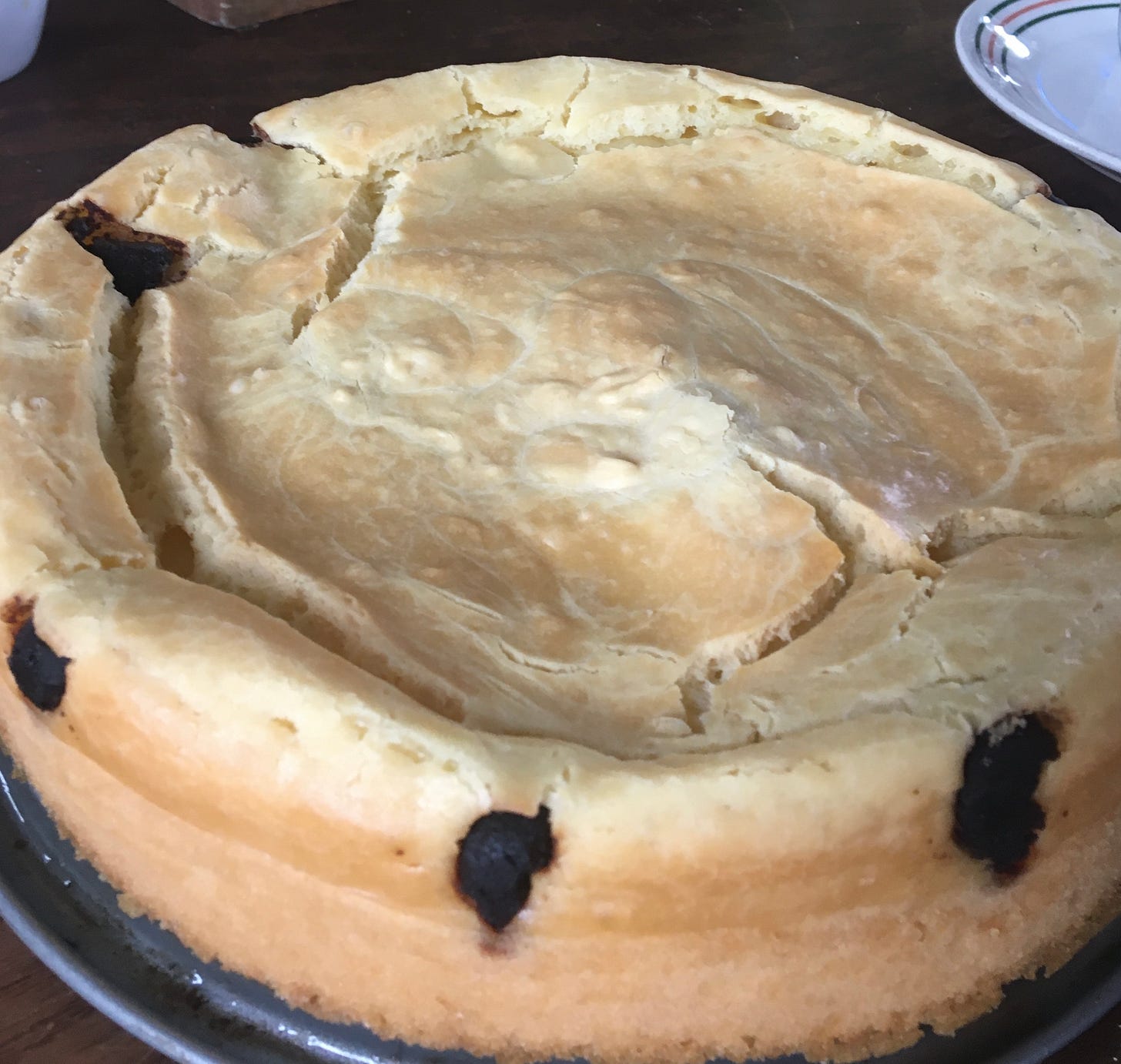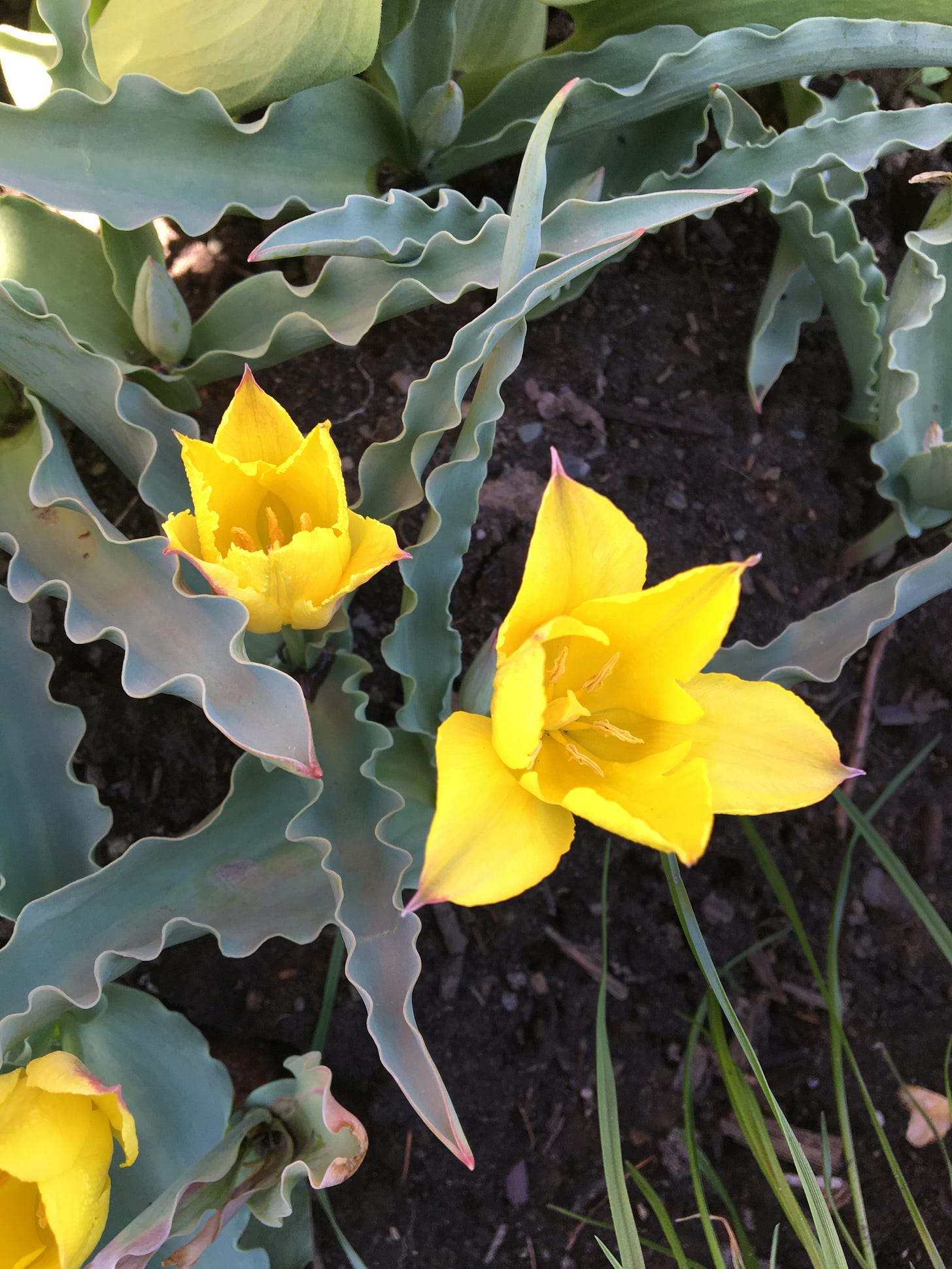Dear bread friends,
I’ve been thinking about possibilities. It's hard to avoid this line of thought as green stems push through matted leaves. One day there were crocuses, then choruses of snowdrops showed up, ready to sing. Then the first daffodil smiled, and a million more opened their faces. Access to vaccines bloomed too! First my mom, then my son and husband because they volunteer at a food pantry, then me because I’m over 50, and now everyone 16+. What a bloom of chances.
My sons are bursting forth. Felix is twitchy with the fever of ideas; his latest is making a houseboat out of a rusty vehicle on railroad ties. Francis turned 23, and we saluted him with two cakes he loves: baked Nián Gāo from the picture book, “The Runaway Rice Cake,” and a double butter cake – a yellow layer cake made mistakenly with twice as much butter when his brother was young and I was very tired.
I think about buildings, and the possibilities they offer for people and communities. The church next door is becoming student apartments. This is not the next life I want for this space! The next house over, my old neighbor Chico never finished building a balcony on his second floor. The beams jut out below the door frame. The new owners are working on the apartment, but I don’t know that they’ll finish the balcony.
Of course, my eye, seeking patterns, is finding other abandoned doors as I walk around my city. On a ranch house with a big yard, a door on the side doesn’t have any steps down to the yard. The door is part of the wall, and still invites entrance. On the top floor of another house, a set of sliding doors worry me. They’re just there, ready to open. Will someone find the handle when they’re sleepwalking?
Doors are metaphors and tools. Edna St. Vincent Millay used doors to delineate outdoor rooms in her gardens. Seeing those doors, “opening” them and walking through, I felt charmed and haunted, like I was entering somewhere. The placement worked. Bread works too, as a metaphor and tool.
I can use flour -- and, with water and guidance, time and heat -- extend myself to my loved ones. In bread, I am offering more than sustenance. The material and emotional exchange is very lively for me right now because I just started trading loaves for eggs! I never did like chicken chores, but I am fond of baking bread, and very fond now of thinking of this family -- a mama, a papa and two little boys whose faces open bright as daffodils when they say hello -- eating my bread.
I can’t get enough of the kids in my life these days, their joy persisting as more people (kids included) are extinguished by police and in mass shootings. The relentlessness of violence stills me, and makes the brilliant yellow-greens of brand new leaves seem dull.
Yet the possibilities of flour keep me going. I think about bakeries as conduit for connections, as Nate Hogue from Brake Bread in St. Paul Minnesota said in a talk co-hosted by the Bread Bakers Guild of America (BBGA) and the Artisan Grain Collaborative (AGC). We hatched the idea for the talk as the anniversary of Neighbor Loaves approached
Neighbor Loaves is an AGC program linking fresh flour to food pantries. As everything closed down last March and bakeries lost both retail and wholesale customers overnight, AGC came up with a plan to help consumers support the entire grain supply chain. Bakers put a Neighbor Loaves option on their online platforms and people bought a full-priced loaf of sliced bread that is made with at least 50% regional flour; bakeries make the bread and it heads to food pantries. Many bakeries are still selling Neighbor Loaves and have “baked” this style of giving into their businesses. Here is a link to the BBGA/AGC talk. I hope you’ll take a look and listen to Katherine Kerhli, founder of Community Loaves; Nate Hogue, Brake Bread; Michele Huggins, Doughp Creations; Scott Mangold, Breadfarm; and Alex Bois from Lost Bread. The talk was uplifting and useful, and got me thinking more about how racial equity & food access can be knit into my work with grains.
All the bread in the world is not going to cure the intertwining issues of safety and justice so many Americans face, but bread and flour and grain systems -- these are what I have, and I can incorporate these pressing issues into my work.
I can use my tools to help shape a better world, a world fueled by considerate and reasonable connections between people, businesses and the earth. Flour can’t do it alone, but flour can be a part of the solutions we must pursue.
Yours,
Amy
RECIPE
Baked Nián Gāo, based on Ying Chang Compestine’s recipe from “The Runaway Rice Cake”
1 pound glutinous rice flour
½ cup sugar
1 tablespoon baking powder
½ teaspoon salt
3 eggs
¾ cup canola oil
1 ½ cups water
½ cup red bean paste
Preheat oven to 375℉.
Grease a 9 inch springform pan with oil.
Whisk together the dry ingredients in one bowl, and the eggs, oil and water in another.
Combine the two, preferably in a stand mixer. Mix for about 2-3 minutes on medium speed. If mixing by hand, whisk thoroughly. The idea is to get a little loft for the cake from beating the batter.
Pour batter into prepared pan.
Roll the bean paste into small balls, and drop into the batter in a random pattern.
Bake for 40 minutes.
As the cake cools and collapses, don’t be disappointed. That’s the way this flour falls.
READINGS
I’ve said it before, but that doesn’t mean I can’t say it again: sign up for Mo Cheeks’ newsletter, Bread & Justice.
Many days, Rowen White’s words help me feel all right about our precarious now. She is a leader in the Indigenous seed and food sovereignty movement, and her writing is a scaffold for my heart to climb. I read her on Instagram, and she writes on Facebook, also. I encourage you to seek her voice, and leave you with these sentences that helped me this week.
“Please don't forget that in any one moment you are held by countless relationships of nourishment and sustenance, support and reciprocity; you are held and nourished with every breathe and meal by mineral, plant, animal and elemental relatives. All of us are, no matter how much we forget, and lash out in our grief of perceived disconnection,” wrote Rowen White.






